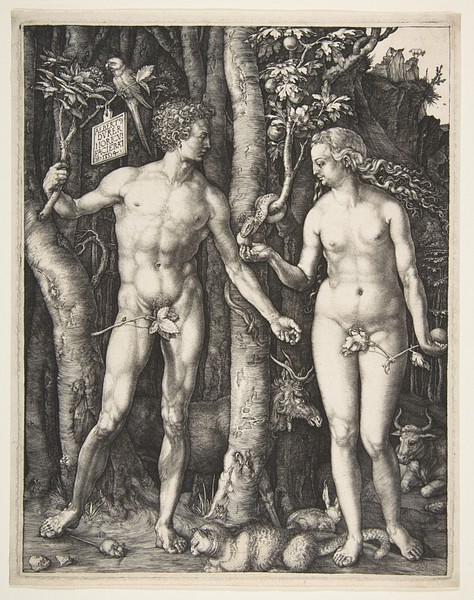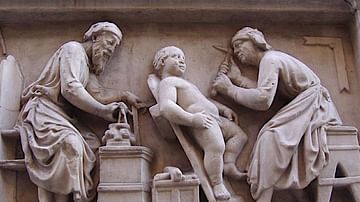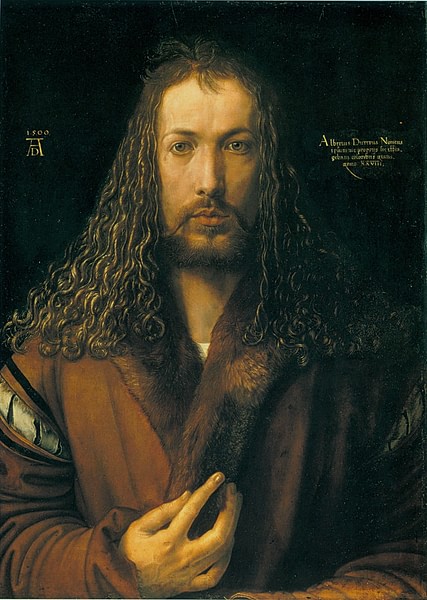
Albrecht Dürer (1471-1528 CE) was a German Renaissance artist who is considered one of the greatest painters and engravers in history. A native of Nuremberg, Dürer was famous in his own lifetime at home and abroad for his oil paintings, altarpieces, drawings, and engraved prints, as well as for his numerous treatises on art theory. A superb draughtsman with an uncanny eye for detail, Dürer's style blended trends in Italian and Northern European art to push Renaissance art ever further along the road to natural realism.
Early Life
Unlike many other Renaissance artists whose personal details and lives are known only sketchily from second-hand sources and later biographers, the events of Albrecht Dürer's life are much easier to reconstruct thanks to the artist's own habit of keeping detailed diaries and notebooks. Indeed, this habit and Dürer's concern to almost always sign and date his work lead one to conclude that he was well aware of his fame and was confident it would endure long after his death. Personal letters are another valuable source of historical information on the artist, as are, of course, his surviving works which include over 2,000 drawings.
Dürer was born in Nuremberg on 21 May 1471 CE, and he would spend most of his career there, even if he frequently travelled to other places. His namesake father was a goldsmith who had emigrated from Hungary. In 1490 CE he would famously paint a portrait of his father. A 1514 CE charcoal sketch portrait survives of Dürer's mother, Barbara Holper, a native of Nuremberg (the sketch is now in the Staatliche Museen of Berlin). The young Dürer learnt draughtsmanship at his father's workshop, and his training in engraving gold pieces would serve him well throughout the rest of his glittering career.
From 1486 to 1489 CE Dürer studied as a painter and engraver apprentice to Michael Wolgemut (c. 1434-1519 CE) who ran a large workshop in Nuremberg. Dürer moved to Basel in 1492 CE and stayed in that city for two years making woodcut illustrations for printed books. One of the famous works the young artist illustrated was the 1494 CE Ship of Fools by the satirical poet Sebastian Brant (c. 1457-1521 CE). The artist likely also visited the Netherlands and Strasbourg in this period. Dürer returned to his home city and married a merchant's daughter, Agnes Fey (1475-1539 CE) in 1494 CE. He then set up his own master's workshop where he worked with a number of assistants and where he trained apprentices. From here, Dürer produced a great number of paintings, altarpieces, and prints, the artist never being out of work for the rest of his life.
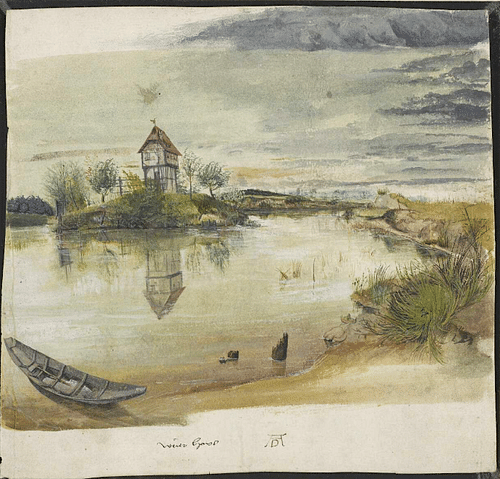
Visit to Italy
In 1495 CE Dürer visited Italy for the first time, spending some time in Venice. Always interested in his surroundings, the artist made several watercolours of the Alps as he crossed into southern Europe. Dürer studied the effects of classical art on contemporary Italian art and was greatly interested in the search for accurate proportions regarding the human body and perspective in painted or engraved scenes. Like other Renaissance artists such as Piero della Francesca (c. 1420-1492 CE) and Leonardo da Vinci (1452-1519 CE), Dürer was convinced that the sculptors of antiquity had discovered the secret mathematical formulas necessary to accurately reproduce human anatomy in art. Mathematics and geometry could also be applied to art to ensure realistic perspective was achieved in paintings and engravings. Dürer would spend the rest of his life researching these possibilities, studying Italian art either in person or print, scribbling copious notes in his diaries, and experimenting with numbers in his own sketches and finished works.
The Engraving Master
Returning to Nuremberg, Dürer continued to make prints, most notably the Gothic-inspired series of 15 prints known as The Apocalypse in 1498 CE. In 1504 CE he painted his celebrated The Adoration of the Magi, which is now in the Uffizi Gallery in Florence. In the same year, he produced one of his most famous (and copied) engraved prints, the Adam and Eve. The art historians P. Nuttall and R. Williams give the following description of this masterpiece:
Dürer's Adam and Eve engraving exemplifies the virtuosic potential of the medium. Through infinitesimally nuanced hatching and stippling, Dürer creates tone and texture, suggesting spatial depth and the textures of flesh, bark, and fur, in a bravura display rivalling the mimetic effects of painting, but in black and white, masterfully balancing the demands of naturalism and graphic design. Dürer's signature on the tablet at top left proclaims his authorship, a form of self-advertisement, like the famous monogram with which he usually signed his prints, following the practice of earlier engravers.
(Campbell, 222).
The above print was made from an engraved metal plate, which gave artists greater precision in their work, but Dürer continued with woodcut prints, too, as copies of these could be produced in much greater numbers. Metal plates tended to wear out faster and so only around 50 prints could be made before they deteriorated. Dürer hired an agent to sell his prints with great success, helped by his godfather, Anton Koberger (c. 1440-1513 CE), owner of the largest print shop in Germany. Dürer also employed both his mother and sister to sell his own prints. Despite the huge demand for prints, the artist did not neglect painting as he continued to make watercolour studies of flora and fauna wherever he went. Clumps of grass, hares, insects, and interesting episodes of light were rendered in exquisite, lifelike detail.
Back to Italy
Dürer once again visited Italy in 1505 CE and, spending two years visiting Venice and Bologna, met such artists as Giovanni Bellini (c. 1430-1516 CE). The two masters admired each other's work. Bellini was influenced by Dürer's obsession with detail while the German artist said of the Italian, he "was very old, but still the best in painting" (Hale, 47). A noted collector of other artist's sketches and prints of their works, Dürer often worked on these to create wholly new works of art. An example of these transformations is his Bacchanal with Silenus (1494 CE) print, which derived from the Battle of the Sea Gods engraving (c. 1490 CE) by the Paduan artist Andrea Mantegna (c. 1431-1506 CE). Dürer had long been an admirer of Mantegna's as prints of his work had reached Dürer in Germany long before he himself travelled to Italy. Dürer would also admire the work of Raphael (1483-1520 CE) and even exchange works with the Italian master in 1515 CE.
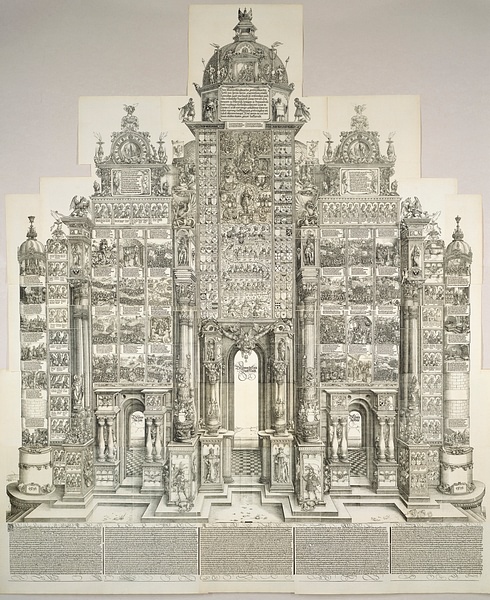
Holy Roman Emperors
Back again in Nuremberg, the artist purchased an impressive four-storey house in 1507 CE, which today functions as a museum dedicated to him. Dürer now produced two famous painted panels, Adam and Eve. The two panels, based on his earlier engraving, are now housed in the Prado Museum in Madrid. By 1512 CE Dürer's reputation was well established, and he was commissioned for various works by Maximilian I, Holy Roman Emperor (r. 1508-1519 CE), including two portraits. Still producing woodcut prints, Dürer made the Master Engravings collection in 1514 CE, which included the celebrated Melancholia I, considered one of his finest copperplate engravings. Made Maximilian's chief court artist, Dürer illustrated the emperor's personal prayerbook and created such noted prints as the Triumphal Arch of Maximilian.
Dürer worked with a team of fellow engravers to produce the composite Triumphal Arch for the emperor around 1515 CE. Just as for ancient Roman emperors, the triumphal arch remained a potent symbol of power and success. Dürer supervised the massive print, which was made up of 192 separately printed pieces. The finished work, measuring some 7 square metres (75 sq. ft), was replicated 700 times c. 1518 CE, and these copies were dispatched to the courts of Europe and the councils of major cities. Curiously reminiscent of Hindu architecture, the arch is enormously detailed and embellished with Maximilian's coat of arms, his family tree, portraits of his family, and various episodes from his reign, making it a powerful message of his right to rule.
When Charles V became the new Holy Roman Emperor in 1520 CE, Dürer served at his court in the Netherlands, but a year later he was once more back in Nuremberg. 1521 CE was another year of travel; this time the artist visited Ghent, Bruges, Antwerp, and Cologne. Besides shopping for materials like rare ultramarine (which then only came from Afghanistan) and buying 22 quality brushes, he visited many churches and admired the detailed work of such renowned Flemish artists as Jan van Eyck (d. 1441 CE). Dürer made copious drawings in a surviving sketchbook which he filled up throughout this trip. Never one to turn down a marketing opportunity, Dürer also distributed prints of his work along the way, especially his 1514 CE Saint Jerome in his Study.
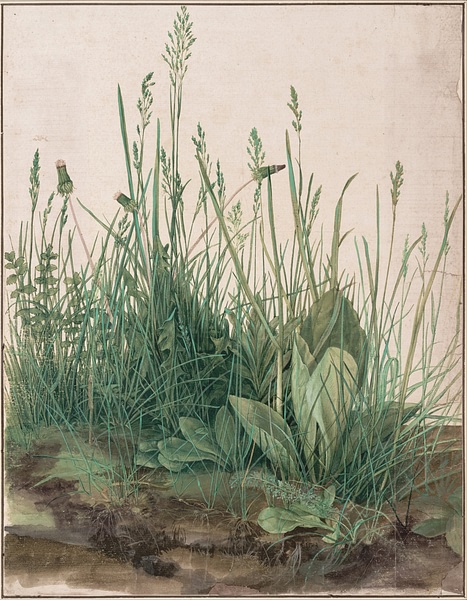
Literature
From around 1518 CE Dürer had begun to take a keen interest in the writings of the Protestant reformist Martin Luther (1483-1546 CE), whom he had met in person in Augsburg. This influence would be seen in the artist's 1526 CE Four Apostles panels for the Nuremberg Council. These paintings were perhaps the zenith of his impressive catalogue of masterpieces in that medium. The figures of John, Peter, Paul, and Mark were each given quotations from Luther's translation of the Bible. The painting is today in the Alte Pinakothek of Munich.
Another area of interest in Dürer's later years was putting his ideas on some of the technical aspects of art into writing. Dürer produced Underweysung der Messung in 1525 CE, a treatise on geometry relevant to both art and architecture, and Vier Bücher menschlicher Proportion in 1528 CE, where he discusses proportion and the relevance of mathematics to art. The works contained many helpful practical notes such as how to draw three-dimensional figures, gave examples of different types of lettering, and offered explanations on how to create devices that gave the measurements needed to achieve a proper perspective of a given subject.

The advice Dürer painstakingly compiled was, though, for a very limited audience, as he himself noted:
The attainment of true, artistic and lovely painting is hard to come unto. It needs long time and a hand most free and practised. Whosoever, therefore, is not gifted in this manner, let him not undertake it; for it comes by inspiration from above. The art of painting cannot be truly judged save by such as are themselves good painters; from others it is verily hidden even as a strange tongue.
(Nash, 288)
Portraits
In 1526 CE, Dürer produced engraved print portraits of various famous names such as the humanist trio of Desiderius Erasmus (c. 1469-1536 CE), Philip Melanchthon (1497-1560 CE), and Willibald Pirckheimer (1470-1530 CE). The artist also painted many portraits and half-portraits of members of the Italian gentry during his visit of 1505-7 CE and prominent Germans thereafter. No portraits are now more famous, though, than those the artist painted of himself. Indeed, Dürer painted himself more than any other Renaissance artist; his first known attempt being a parchment drawing dating to 1493 CE.
The most famous of Dürer's self-portraits is the c. 1500 CE oil on wood panel painting, now on display in the Alte Pinakothek in Munich. Aged 28, the artist is wearing a fur-trim coat and long curly hair. The picture is so realistic one has the somewhat unsettling feeling that the artist is gazing at the viewer in person and daring him to contradict that here indeed is one of the greatest artists in history. Certainly his dog was impressed, said to have licked the painting such was the realistic effect of his master in oils. Dürer must have been pleased with his work, too, since he signed it twice. His monogram and the year 1500 CE is on the left side, and on the right are the words: "I, Albrecht Dürer of Nuremberg painted myself thus, with undying colour, at the age of 28 years". Both signatures are placed prominently at the eye level of the face.
The full-frontal pose, long hair, beard, and hand gesture are all reminiscent of standard portrayals of Jesus Christ and perhaps indicate Dürer's belief - reflected, too, in the wider Renaissance world - that he was no mere craftsman but a creator of beautiful things that required both manual skill and intellectual endeavour to produce. Certainly, the expensive fur coat is a nod to this yearning for respect for the artist, something which was more forthcoming in Renaissance Italy than Dürer's Germany, as attested in the following line from a personal letter written by Dürer when in Italy, "O, how cold I will be away from the sun; here I am a gentleman, at home a parasite." (Ruhmer)
Legacy
Dürer died on 6 April 1528 CE in Nuremberg, where he was buried. He had already achieved fame in his own lifetime and was celebrated both in Germany and Italy as one of the great Renaissance artists. Fine engraved prints of his major works made their way abroad, further spreading his fame. Jesuit missionaries used his prints in their work and so they even found their way to such distant places as the Mughal Empire in India. His reputation only grew after his death. Dürer was mentioned frequently in the celebrated history of Renaissance artists The Lives of the Most Excellent Italian Architects, Painters, and Sculptors (1550 CE, revised 1568 CE) by Giorgio Vasari (1511-1574 CE). According to Vasari, Dürer's work influenced such Italian artists as the engraver Marcantonio Raimondi (1480-1534 CE) and the painter Jacopo da Pontormo (1494-1557 CE), amongst many others. Dürer's reputation was certainly enduring, and his work has been collected by such art lovers as Rudolf II, Holy Roman Emperor (r. 1576-1612 CE) and many others besides ever since.
